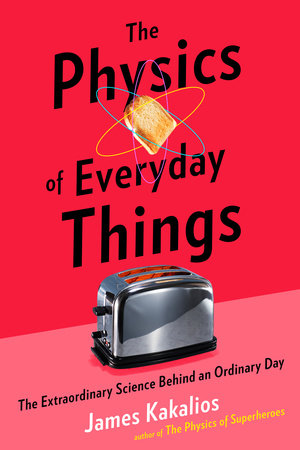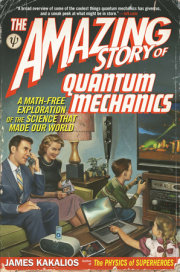Chapter One
You Begin Your Day
It is early morning, and you’re asleep in bed. Your slow, regular breathing and steady pulse mark the passage of time, bringing you closer to when you must get up and begin your day. Today will be a busy one, with a visit to the doctor followed by a flight to another city for a business presentation. The vintage clock on your wall, a gift from your grandmother, provides a comforting tick, tock as the small bob hanging from the body swings rhythmically back and forth. Although the clock keeps good time, you rely on the alarm setting of your smartphone to wake you. But the first sensation that will register the start of your day will not be your hearing; it will be your sense of smell. Last night you set the digital timer on your coffeemaker to start its brewing cycle ten minutes before your phone’s alarm will go off. Your room soon fills with the aroma of fresh coffee, and you begin to stir.
The elegant physics of an oscillating pendulum underlies the working of both the clock on the wall and the electronic timer on your coffeemaker, and plays a crucial role in many of the devices you will use as you prepare for the day.
A pendulum is a very simple device, consisting of a string, fixed at one end, with a mass, termed the “bob,” attached at the other end. The oscillations of the pendulum bob provide visual confirmation of one of the most important concepts in physics, that of the principle of conservation of energy: “kinetic energy,” the energy of motion, can only be converted to “potential energy” (the energy associated with a force acting on an object and the distance over which that force can cause motion) and vice versa. In a pendulum, you can increase the potential energy of the mass on the string by lifting it up, rotating the bob to a higher level while keeping the string taut, doing work against the gravity that pulls down on the bob. Once you release the bob, its potential energy is converted into kinetic energy as it moves in an arc of a semicircle. As the bob swings to the other side, the kinetic energy is converted back into potential energy. Both the starting height and the final height at the other end of the arc are the same—when you release the mass and don’t push it, it can never rise to a greater height than where it started.
A pendulum is useful for keeping time. The time it takes for the bob to complete a full cycle as it swings back and forth does not depend on how heavy the weight is, or on how high the mass is lifted to start it swinging (at least, for relatively small excursions back and forth). The greater the height of the mass, the larger the arc as it swings back and forth, and the larger the kinetic energy and speed it will have at the bottom of its arc. The longer distance and the faster speed exactly balance out, so that the time it takes to complete a cycle is the same—regardless of how high the bob is raised. The only factor that controls the time for a cycle is the length of the string. A pendulum whose string is just a little less than ten inches long will take one second to complete a full oscillation. As it swings, some of the kinetic energy of the bob is transferred to the surrounding air, pushing the molecules out of the bob’s way. A careful audit will find that the gain in kinetic energy of the air is exactly equal to the reduction of the total energy of the pendulum, which is why mechanical clocks—grandfatherly and otherwise—need periodic winding.
It’s as true for the digital timer on the coffeemaker as it is for the mechanical pendulum—to mark the passing of time, one needs a power supply (as everything, even counting seconds, requires a source of energy) and a way to convert that energy into a periodically varying cycle. The coffeemaker is plugged into an outlet connected to an external electric power grid. Conveniently for us, the mechanism by which electric power is generated at a power plant automatically leads to an electric current that oscillates back and forth like a pendulum that can be exploited when making a timer.
Your electric company rotates coils of wire between the poles of large electromagnets, and to see how that leads to an alternating electric current, let’s return to the simple mechanical oscillating pendulum. Let the bob at the end of the string have an electric charge, say from a few extra electrons sitting on it. Even if this pendulum has a frictionless pivot point and is swinging in a perfect vacuum, with no air drag, it will eventually slow down and come to rest. Where did the bob’s energy go? Into electromagnetic waves, demonstrating a profound symmetry between electric and magnetic fields that will be exploited repeatedly throughout your day.
An “electric current” is defined as the motion of electric charges moving together, and as the electrically charged bob swings back and forth, changing its speed, it is a constantly changing current. The current is large at the bottom of the arc, when the bob is moving at its fastest, and the current is zero at the top of the arc, when the bob is momentarily stationary. Moving electric charges, as in a current, generate a magnetic field (this is known as Ampere’s law); the faster they move, the larger the magnetic field. The swinging bob, creating a constantly changing current, generates an equally varying magnetic field. In turn, this changing magnetic field generates a varying electric field (known as Faraday’s law). This rhythmic oscillation of electric and magnetic fields is termed an “electromagnetic wave,” which will have the same frequency as that of the oscillating bob. These waves carry energy, and thus it takes energy to create them. This is why the oscillations of an electrically charged bob will slowly die out, as its energy of motion is converted into electromagnetic waves. We could see these electromagnetic waves with the naked eye if the pendulum were swinging back and forth very rapidly (say, a thousand trillion times a second), in which case these waves would appear as visible light.
The power company employs the basic physics of electromagnetism when it generates the electric voltage available from the wall outlet, using coils of wire rotating between the poles of a magnet. The voltage provided by your electric company alternates smoothly from a positive voltage to a negative voltage, and back again, forming a wave that is mathematically identical to the variation in position of the pendulum bob as it oscillates back and forth, and is a natural consequence of how the electricity is produced. (This is why our electric power is called AC, for “alternating current.”) The power plant is applying Faraday’s law, which describes how a changing magnetic field will generate a voltage. As the coil turns, the magnitude of the magnetic field passing through the circular area of the coil varies, and a voltage is generated that sets up a current in the coil. Think of the coil as a spool of thread with a very large diameter. When the area of the coil is facing the poles of the magnet, most of the magnetic field passes through it (along the length of the spool), but when it rotates by ninety degrees, hardly any of the field passes through the coil’s area. A uniform rotation speed yields a smoothly varying voltage that changes back and forth in time, just like the motion of the pendulum bob. In the United States, the coils rotate sixty times a second, which is the frequency of the alternating voltage that is generated.
The fact that the voltage in the wall outlet varies smoothly back and forth sixty times a second means that it takes only 0.0167 second to complete one cycle. To slow this period down, the coffeemaker’s timer uses specially designed chips that shift the frequency of the alternating voltage. One chip divides the incoming frequency by ten, so a voltage wave that oscillates sixty times a second now does so six times a second. Another chip divides this frequency by an additional factor of six, so the frequency of six cycles per second is reduced to one cycle per second. This slower voltage wave is sent to another chip, which counts the number of times the voltage has its largest positive value (equivalent to watching how often the pendulum bob returns to its original starting position). This “counting” chip monitors the passing seconds, and with a little amount of additional circuitry, this information can be displayed on a digital clock. When you set the timer on your coffeemaker, you are instructing a chip to monitor this counting chip, and when the sum reaches a certain value (the time you specified for the coffeemaker to turn on), it sends another voltage to another part of the electronic system. This voltage is the same as the one created when you press the on switch manually, and the brewing process begins.
The system for measuring time begins when we plug in the coffeemaker and set the correct time. If the coffeemaker is unplugged, then this preset is lost. So how does an electronic timer work when it is not connected to the external alternating-current power from the wall outlet?
The coffee vapors waft into your room and are recognized by your still-not-fully-awake mind. In addition to setting the timer on the coffeemaker last night, you set the alarm clock on your smartphone. The alarm goes off, playing a preset tune stored in the phone’s memory chip. You grumble as you check the time, because it is earlier than you normally need to get up. You are tempted to tap the alert marked snooze. But as you inhale the coffee aroma, you notice your packed overnight bag sitting in the corner of your bedroom. Reminding yourself that you have a long day in front of you, you force yourself out of bed. Getting to your feet, you wince slightly as you put weight on your left foot. It will be good to get that looked at today.
The problem of keeping time in a device not connected to an external electrical power supply is an old one; in fact, it predates the existence of electrical power. Old-fashioned alarm clocks used springs, and when the hands on the face of the clock reached a set point, a lever would be flipped, releasing another coiled spring. This other spring would then oscillate a striker bar between two metal shells, creating a clanging noise loud enough to wake the dead. The alarm in your smartphone is smaller, and the wake-up tune is less jarring, but the principle behind its operation is essentially the same.
Your smartphone uses something called a piezoelectric crystal to replace the mechanical spring in an alarm clock. Let’s look at simple springs first, piezoelectric crystals second.
Springs make for very good timekeepers. Springs resist being stretched or compressed, and respond with a force that opposes the change in their length. The more the spring is stretched or compressed, the greater the opposing force. Hang a coiled spring from the ceiling, and attach a weight to its end. The spring will stretch down, with the spring providing an upward force, opposing the stretching and balancing the downward gravitational pull of the weight. If you pull the weight down a bit more and let it go, the upward force from the spring is now larger than the downward force of the weight, and the weight moves upward, speeding past its original position. As the weight overshoots, it compresses the spring, and the coil responds with a downward force, now opposing the squeezing and pushing the weight back toward its starting location. The weight will go up and down periodically, with a motion no different from the swinging pendulum bob and the alternating voltage from the wall outlet. The natural frequency of the spring’s oscillations (the number of up-and-down cycles per second) is determined by its stiffness and how much weight is hanging on its end.
The origin of the force in a spring that resists being stretched or compressed is the same as in the piezoelectric crystal in your smartphone—electricity. The atoms in all solids are held together by electric forces, which also make sure that the atoms stay in specific locations. If two neighboring atoms in a solid get too close to each other, there is a repulsive force between the electrons from each atom that pushes them back apart. Imagine an atom in a crystal as a simple ball. Let’s represent the chemical bonds holding the atom in place as springs attached to the atoms on either side. Push this atom away from its natural position in a solid, and its surrounding electrons will encroach too closely on its neighbors on one side, and be too far away on the other. This creates an unbalanced force that will push the atom back toward its equilibrium position. That force will decrease by the time the atom is back to its natural spot in the crystal, but due to its kinetic energy it will overshoot and now move toward the neighboring atom on the other side. It will oscillate back and forth around its preferred location, with the amplitude of vibration depending on the solid’s temperature, and the frequency of oscillation depending on the mass of the atom and the stiffness of the chemical bonds holding it in place in the solid. This vibration of the atoms happens in all solids: this book, the chair you are sitting in, even you yourself.
Electronic timekeepers, such as a digital wristwatch and your smartphone, use a special oscillator that is much more accurate than a coiled spring—a quartz crystal. Quartz is a solid composed of molecular units of silicon dioxide, the chemical composition of sand. Quartz crystals have a special property: the electric charges of the molecular units line up to create a net electric field along the length of the solid when it is squeezed in one direction. This type of material is called piezoelectric: piezo, in Greek, means “to squeeze or press,” and a piezoelectric material is a solid that generates a voltage when it is squeezed. For certain materials and crystal structures, when two sides of the solid are pushed together, all the atoms buckle in just the right way to create a large, net electric field.
To use a piezoelectric crystal as a timing device, we run this process backward. That is, we apply a voltage across the solid, and the crystal sides pull together, as if compressed by an external force. Once the voltage is turned off, the crystal will expand, and it begins to oscillate at its natural frequency. That frequency is determined by the size and shape of the crystal, and can range from a few thousand cycles per second to as high as several hundred million cycles per second. As the quartz crystal oscillates, it generates a voltage at this same natural frequency that can be used to maintain the crystal’s vibrations. As in the digital timer, computer chips reduce the quartz crystal’s high frequency down to one cycle per second. Once the preset time is reached, a signal voltage is sent to another chip. In the coffee maker, this second chip starts the brewing process for the coffee, while in your phone it initiates playing a preselected musical tune.
Copyright © 2017 by James Kakalios. All rights reserved. No part of this excerpt may be reproduced or reprinted without permission in writing from the publisher.













